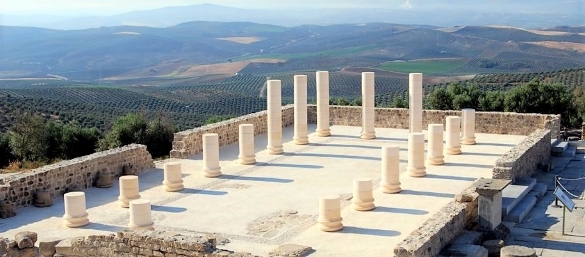
Main photo: Torreparedones Roman ruins near Baena (El Pais - photo: Museo Historico de Baena/EPV).
Local archaeologists believe it could be the largest olive mill yet found in what was the Roman province of Baetica (Andalucia).
So how did Roman olive mills work; how much olive oil was exported to imperial Rome 2000 years ago; and which are the most important Roman sites you can visit in Andalucia and the rest of Spain.
Artist´s impression of a Roman olive oil mill (National Geographic).
An exciting archaeological site has been discovered during construction works on a new road leading to our local town, Priego de Cordoba. Late last year, archaeologists discovered the ruins of a large, fortified Roman olive mill complex right in the proposed path of the new A-333 road, near to the beautiful Los Angosturas gorge. See photo below.

Roman olive mill discovered near Priego de Cordoba.
The site occupies a dimension of 1,600 square meters so far; but is expected to be significantly larger when fully excavated. The structure of the streets of the old town has been well preserved, with walls more than two meters thick and the remains of a natatio (Roman bathing pool) and a lararium (altar for offerings) have also been found.
Aerial view of the Roman site discovered during construction works, Priego de Cordoba.
The Andalucian government has described it as “a site of great historical importance - a very unique space due to its link with the production and commercialization of olive oil, and its close relationship with the communication routes during Antiquity”. So, the new road will now be diverted and these Roman ruins will now be properly excavated; so that Priego de Cordoba will be blessed with a new cultural attraction for future visitors.

The old town streets of Priego de Cordoba.
This often happens around here – anytime anyone digs deep, there tends to be something of major cultural value unearthed! A short drive away, we have one of the finest examples of a Roman villa in Spain (Almedinilla) and the country´s largest medieval Jewish necrópolis (Lucena) – both found by chance when they were building a new road. The incredible Moorish heritage of medieval Al Andalus is the most well-known historical period here in Andalucia; but the region also boasts so many other layers of history and different cultures before that - from the Neolithic and Bronze Age peoples, to the Iberos, the Romans, Sephardic Jews and Visigoths. Located right in the heart of Andalucia, we are literally surrounded on all sides by ancient history! See map below for a few examples of historic sites nearby.
From the house here at Casa Olea we can see an 11th-century Moorish watchtower and a 2500-year-old Iberian hill fort; plus the Subbetica is home to several Moorish castles (Priego, Luque, Carcabuey, Iznajar) and the finest Baroque churches in Andalucia (Priego).
* The Roman olive oil mill
This archaeological site just discovered in Priego de Cordoba has unearthed a major olive oil mill complex (from the 1st or 2nd century AD), with at least 8 buildings made up of 4 different spaces and a paved street connecting them. The large rectangular torcularium (olive mill building) has been identified with its opus spicatum (paved floor); together with the tabulatum (olive reception room), the trapetum (grinding machine), mola olearia (mill stone), a system of channels for the olive oil collection and the cella olearia (olive oil cellar/store). The largest street found is over 6 metres wide - over twice the width of any others found in Cordoba province so far – suggesting that this olive mill complex would have been a key point on the olive oil production network of Roman Baetica, connected to the main trade route linking Antequera and Cordoba.
Artist´s impression of a Roman olive oil mill complex (National Geographic).
* The Roman olive oil trade in Andalucia
The industrial-scale production of olive oil, as well cereal crops and wine, in Baetica spanned much of modern-day Andalucia - from the fertile plains along the Rio Guadalquivir between Cordoba and Seville; to the banks of the Rio Genil (see map below) between Granada and Palma del Rio, where it joins the Rio Guadalquivir, the Sierras Subbeticas and towards Jaen in the north. Vast quantities of olive oil were transported big distances across southern Spain, using wineskins and ceramic jars (amphora), to take the olive oil from the farmland to the rivers and then on to the coast in barges; for shipping to Rome and further afield to key frontier military camps in parts of the empire such as Britannia (UK), Germania/Retia (Germany/Austria).
Towns were established along both these rivers as trading ports such as Puente Genil, Palma del Rio and Almodovar del Rio and one of the region´s most important administrative/customs centres was established in Ecija. The region benefited economically hugely from the trade, with supporting industries created such the alfarerias producing the ceramic amphora jars on a huge scale; and the local elites (from provincial governors and landowners to the olive oil merchants) became very wealthy from it. Today, it is possible to visit the ruins of their luxurious country mansions in Almedinilla and Puente Genil in the Subbética.
The remains of over 100 Roman pottery workshops (alfarerias) have been discovered along the banks of the Guadalquivir (such as in Alcolea del Rio) and Genil rivers, forming a triangle between three of the four administrative capitals of Baetica: Hispalis (Seville), Corduba (Cordoba) and Astigi (Ecija) - the fourth one being Gades (Cadiz), the main port. The larger ships used for the journey from Cadiz to Rome would have carried between 3000 and 6000 amphora each. Once the ships arrived in Rome, the olive oil was decanted into smaller containers, for easier distribution within the city. The original large amphora had to then be discarded, as they could not be “recycled” due to their thickness and because each one contained export data relating to the original shipment.

Roman temple, Cordoba.
* Monte Testaccio – the ancient world´s largest landfill!
“For more than 250 years, from at least the first century A.D., an enormous number of amphoras filled with olive oil came by ship from the Roman provinces into the city itself, where they were unloaded, emptied, and then taken to Monte Testaccio and thrown away..” Archaeology magazine. An estimated 25 million ceramic amphora were dumped in Monte Testaccio, next to the large warehouses along the River Tiber – being covered first in a thick layer of white lime to mask the smell of rancid leftover oil and stacked methodically in terraced rows to create the hill it is today.
Monte Testaccio hill made up of Roman amphora (Archaeology magazine).
Excavations at the site, first by German archaeologist Heinrich Dressel (1872) and more recently since the 1960s, have confirmed that over 85% of these amphora came from Baetica, with the remaining 15% from modern-day Libya and Tunisia. It is estimated that, at its peak in the 2nd century AD, up to 130,000 amphora were dumped each year! Most vessels carried between 50-75 litres, so even a conservative estimate makes that 7 million litres a year – easily enough olive oil to feed 1 million people. In addition to being one of the staples of their Mediterranean diet, olive oil was also used in ancient Rome for bathing, medicine, lighting and as a mechanical lubricant.
So, Monte Testaccio is not one of Rome´s natural hills, but it is a 150-foot-tall garbage dump made up solely of discarded ceramic amphora. “With such a high volume of imported oil, the Romans needed a system to control distribution and deter cheating and fraud. One of the many advantages of amphoras is that they are easy to write on. Each one carries a thorough accounting of its contents and of the people involved in its creation and transfer. These inscriptions include stamps and incised marks (see below) made before firing that refer to the production of the amphora and tituli picti - words, names, and numbers painted on after firing. Both provide a wealth of information about the production, administration, and transport of oil”.
Inscriptions on Roman amphora at Monte Testaccio (Archaeology magazine).
Monte Testaccio is a treasure trove for archaeologists, providing a unique record of Roman commerce: “There’s no other place where you can study economic history, food production and distribution, and how the state controlled the transport of a product,” says José Remesal of the University of Barcelona, co-director of the most recent Monte Testaccio excavations. As Archaeology magazine says about Monte Testaccio “in a way no that no temples, triumphal arches or arenas ever can be, it is incontrovertible evidence of the Romans´ ability to move the empire´s vast resources in an organized fashion, to feed their people, and to offer them a previously unknown level of stability.”
Map of the Roman Beaitca Route (Betica Romana.org).
Ruta Betica Romana in Andalucia
Twenty five years ago, the Andalucian tourism department set up the “Roman Baetica Route” as a way of linking the shared Roman heritage of different regions of Andalucia. The aim was to help preserve, maintain and promote the artistic and historic legacy of Roman Andalucia. It was also to suggest a route through the region which offers a fascinating mix of cultural sites and scenery - from the Mediterranean coast and fertile Guadalquivir valley, to the mountains and ancient olive groves of the Sierras Subbeticas. Add to that the three great historic cities of Cadiz, Seville and Cordoba and you have the base of a fabulous road trip in southern Spain.
Passing through 15 towns, the route runs through the southernmost province of what was Roman Hispania and covers territories through which the ancient “Via Augusta” passed through. The destinations included in the Ruta Betica Romana are Seville (Santiponce & Italica), Carmona, La Luisiana, Ecija, Almodovar del Rio, Cordoba, Montoro, Baena (Torreparedones), Almedinilla, Puente Genil, Osuna, Machena, Jerez, Cadiz and Tarifa.

Roman bridge and mezquita in Cordoba.
From the 3rd century BC to the 5th century AD, the Baetica region was one of the territories annexed to form part of the Roman Empire. Under Roman rule, the region was recognized for its olive oil and cereal production, its mining and for the high level of Romanization of its inhabitants.
Did you know? Two of Rome´s greatest emperors, Trajan and Hadrian, were born in Itálica (Seville), while Marcus Aurelius´ family were originally from a small town near Cordoba, (Ucubi - Espejo). What´s more, Rome´s most famous emperor, Julius Caesar, spent part of his political apprenticeship in southern Spain (Hispania Ulterior) and the battle which finally established him as Rome´s undisputed dictator was in Andalucia (near Osuna). The battle of Munda in 45BC was the final battle of the Roman Civil War, with Caesar defeating the last remaining forces loyal to Pompey the Great.
There are lots of large Roman sites in Spain, with impressive temples, amphitheatres or aqueducts (see list below). However, as with Monte Testaccio in Rome, sometimes it is the smaller sites – which may not amaze the visitor by their beauty or monumental engineering – that give the visitor a fascinating view of local society and demonstrate the astonishing level of trade that was established in the Roman empire and the incredible wealth that it generated. Here are three such sites, located close to us here in the Subbetica, which are “off the tourist map” but are well worth a visit...
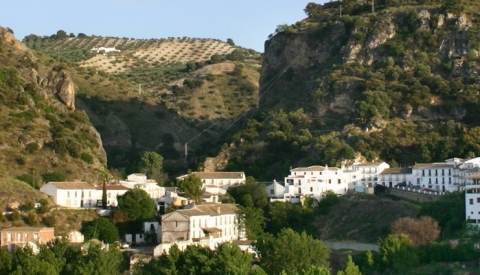
Almedinilla, one of the white towns of the Subbetica.
* Villa Romana El Ruedo, Almedinilla
Dating from the 1st to the 6th century AD, the Villa Romana El Ruedo is one of the most complete and best-preserved Roman villas found in Spain. It was discovered by chance during the construction of a new bypass road (A-339) between Priego de Cordoba and Alcala La Real. The plan of the villa has two distinct areas – the Pars Urbana, the luxury residence of its owners; and the Pars Rustica, the agricultural, working part. The residence is in a good state of conservation and due to the richness of its mosaic floors and painted mural walls, is thought to have been the home of a wealthy olive oil baron or provincial governor. In addition to the family bedrooms surrounding the central porticoed patio, this mansion once had sumptuous reception halls, a dining room with artificial waterfall and a “spa” with hot baths and steam room.
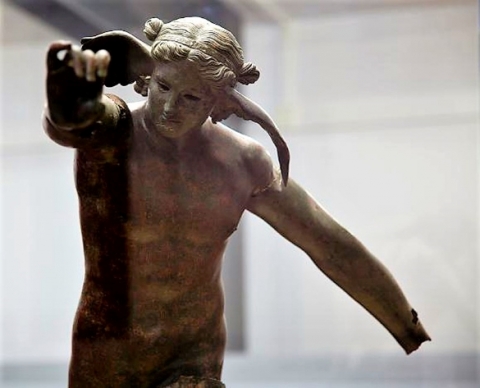
Photo: Roman bronze sculpture, Almedinilla museum.
The agricultural part of the villa includes an olive oil press, grain silos, a wine press, water reservoir, pottery kilns and a metal-worker area. Next to the villa, a necropolis with 340 tombs dating from the 4th to 7th centuries has been unearthed. The finds from excavations made in the 1990s can be seen in the Historical-Archaeological Museum, located in an attractive building next to the Rio Caicena, which was once an olive oil mill and flour mill. Its exhibition space is divided into four rooms: Oil and Olive Room; Mill and Cereal room; Iberian Culture Room (with objects from the Cerro de la Cruz site) and the Roman Culture room. One of the museum's main jewels is the bronze sculpture of the god Hypnos (see photo above), personification of sleep in classical mythology, dating from the 2nd century AD.
* Villa Romana Fuente Alamo
Located just a few km outside of Puente Genil, surrounded by olive groves on the edge of the Sierras Subbeticas, is the site of the Fuente Alamo Roman Villa. Like all of the other agricultural villas of the time in the wider Rio Genil valley, Fuente Alamo would have been part of the affluent Astigi (Ecija) administrative zone. From the 2nd to 4th centuries AD this area was booming commercially, thanks to the huge trade in olive oil, cereal crops and wine. It´s still a very fertile area and is known locally for its delicious carne de membrillo (quince jam) and olive oils, of course! What sets the Fuente Álamo Roman villa apart is the stunning quality and well-preserved state of its mosaic floors. The amazing array of mosaics says a lot about the artistic taste, purchasing power and social status of the owner of the estate - this luxurious palace complex clearly belonged to a very wealthy individual!

Photo: Roman mosaics in Fuente Alamo roman villa, Puente Genil.
Dating from the 3rd and 4th centuries AD, the Fuente Alamo Roman Villa has one of the most important mosaic ensembles in Spain. Romans used mosaics to present the most varied scenes - of nature, daily life, games or the gods. So far in Fuente Alamo, the figurative mosaics represent images linked to the world of the gods. There are three mosaics in particular that stand out in Fuente Alamo: i) Scenes from the life of Dionysus; ii) The Three Graces and iii) The Nilotic mosaic – a unique mosaic depicting comic-like stories about the River Nile, with hippos, crocodile, cranes and pygmies!
Mosaic at Roman villa near Puente Genil (Villa Romana Fuente Alamo).
The house itself would have been extremely spacious, with the owner living there in great luxury, together with his family and most trusted personnel. The large reception room with a square floor plan, was once topped by a semi-circular carved headboard – a dramatic first impression for him to flaunt his power to visiting clients or friends. There would have been several dressing rooms, bedrooms and a large room for worship that ends in an apse. On the other side of the stream, there are other living areas and a set of private baths.
Roman mosaics - the way to "flex" your power, social standing and fortune!
Mosaic is a decorative art used to pave floors or decorate walls, which uses tesserae - small pieces of glass, marble, ceramic or stone - to create images or drawings. The making of a mosaic was a very laborious task that required very skilled labourers and a large number of people. Most of these artisans moved from one city to another to carry out the work – usually remaining anonymous (not signing their work). Even less is known about their clients. Although we can always say that the mosaic is an expression of power, a reflection of the social position and fortune of the client.
Another series of spectacular Roman mosaics can be seen in the Municipal History Museum of Ecija in the Benamejí Palace, which is well worth a visit.
* Torreparedones archaeological site
After 30 years of excavation, a Roman city is emerging from the olive groves! Hidden under the olive trees for centuries and occupying the highest point of the Cordoban campina, the city of Virtus Iulia was built between 30 and 27BC on the site of a fortified Iberian settlement. Experts believe that it would have been a major economic centre, due its strategic location overlooking the fertile plains between the Rio Guadalquivir and Rio Guadajoz. The city once had huge city gates, a market, basilica, baths and a large forum with statues of Roman emperors such as Augustus, Livia and Caligula – all now on show in the Baena Historical and Archaeological Museum (see photo below).
Roman forum at Torreparedones near Baena, Cordoba (El Pais - photo: Museo Historico de Baena/EPV).
And as recently as 2019, archaeologists have discovered the city´s amphitheatre. Just 10% of the city has been excavated so far, including the Forum and public baths, while the amphitheatre still lies tantalisingly hidden under the olive trees! But thanks to excavation work by experts from Cordoba and Granada universities, they have now discovered the location of the amphitheatre and theatre. The preliminary studies in 2017, using aerial Lidar laser technology and digital elevation models, identified the circular “footprint” of the arena. Now, by using geophysical survey techniques and further excavations - with six trenches dug to confirm the positions of the arena´s outer walls - the archaeologists have established its real dimensions. The remains of a gladiator helmet were even found during the most recent dig!
Located outside the walls of the city, but connected by a broad avenue for large numbers of spectators, the amphitheatre would have had a radius of around 70 metres and probably had a capacity of around 5000 spectators. This is consistent with other amphitheatres found in other small/medium sized Roman settlements in Spain, like Segobriga near Cuenca. The baths, which were also discovered recently in an excellent state of preservation, cover around 500 square meters. Rectangular in shape, there is still evidence of changing rooms, a cold room, a warm room and a hot room as well as latrines, a hall and service area, and ovens to heat the floor.
Also at the Torreparedones site, an Iberian sanctuary from the 6th century BC has been unearthed, with hundreds of offerings and small sculptures were found. And, to add to the different layers of history, there are the ruins of a medieval castle on the top of the hill. Dating from the 13th and 14th centuries this castle would have been built to guard the border between Castilian Spain and Nasrid Al Andalus. The views from the top are spectacular, looking down over the archaeological site and to the plains all around.
* TOP ROMAN SITES IN ANDALUCIA

Cordoba - Roman bridge and theatre

Acinipo near Ronda - Roman theate
Carmona - Roman gateways, necropolis and bridge
Malaga - Roman theatre

Italica / Santiponce near Seville - Roman amphitheatre and theatre
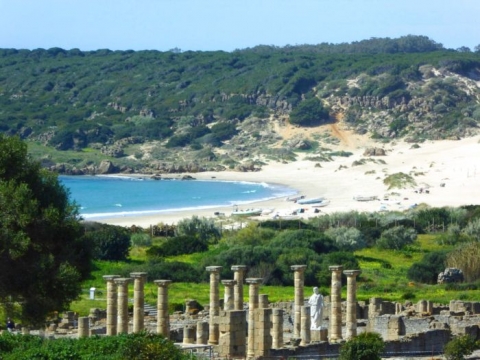
Baelo Claudia, near Tarifa - beachside Roman town.

FAMOUS ROMAN SITES IN SPAIN
Segovia - Roman aqueduct (Castilla y León)
Merida - Roman theatre and amphitheatre (Extremadura)
Tarragona - Roman amphitheatre & Ferreres aqueduct (Catalunya)
Lugo - Romans city walls (Galicia)
Cartagena - Roman theatre (Murcia)
Segóbriga, near Cuenca – Roman amphitheatre & archaeological park (Castilla y La Mancha)
A Coruna - Tower of Hercules Roman lighthouse (Galicia)
Las Medulas, near Pontferrada - Roman gold mine (León).
------------------
* Casa Olea is a 6-bed boutique B&B situated in the beautiful Sierras Subbéticas mountains close to Priego de Córdoba, just 90 minutes´drive inland from Malaga and ideally placed for day trips to Córdoba (Mezquita) and Granada (Alhambra). Rated as one of the Top 25 Best B&Bs/Inns in Spain on Tripadvisor from 2010 to 2023.



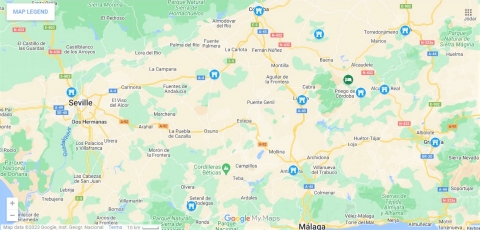

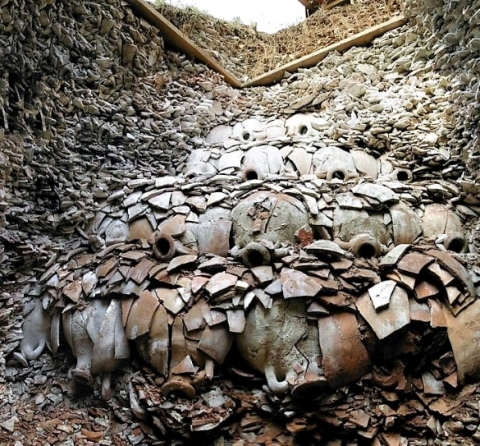


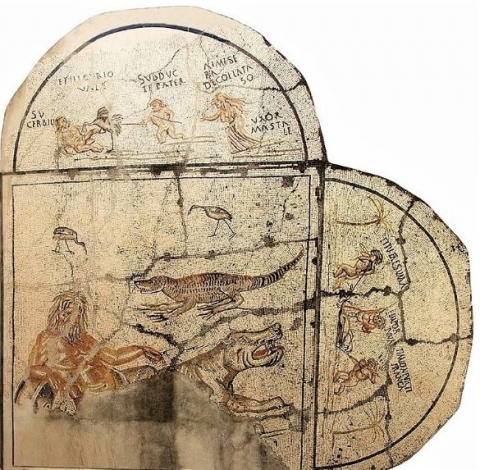



Add new comment